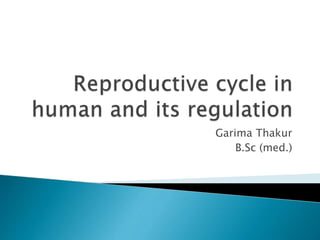Reproductive cycle in human
1)The menstrual cycle refers to the changes and the preparation that a women body goes through to prepare for pregnancy. 2)About once a month, the uterus grows a new lining (endometrium) to get ready for fertilized egg. 3)When there is no fertilized egg to start the pregnancy, the uterus sheds its lining starting off the monthly menstrual bleeding also called menstrual period. 4)The average cycle is 28 days, although it is perfectly normal to have a cycle in that is as short as 21 days or long as 35 days. 5)A regular menstrual cycle is an important element of successful concepton. #The four main phases of menstrual cycle are : 1- menstruation 2- the follicular phase 3-ovulation 4-the luteal phase.

Recomendados
Recomendados
Mais conteúdo relacionado
Mais procurados
Mais procurados (20)
Semelhante a Reproductive cycle in human
Semelhante a Reproductive cycle in human (20)
Último
Último (20)
Reproductive cycle in human
- 2. The menstrual cycle refers to the changes and the preparation that a women body goes through to prepare for pregnancy. About once a month, the uterus grows a new lining (endometrium) to get ready for fertilized egg. When there is no fertilized egg to start the pregnancy, the uterus sheds its lining starting off the monthly menstrual bleeding also called menstrual period.
- 3. the average cycle is 28 days, although it is perfectly normal to have a cycle in that is as short as 21 days or long as 35 days. A regular menstrual cycle is an important element of successful concepton.
- 4. The four main phases of menstrual cycle are : 1. menstruation 2. the follicular phase 3. ovulation 4. the luteal phase.
- 7. The menstrual phase is the first stage of the menstrual cycle. This phase start when an egg from the pervious cycle isn’t fertilized. Because pregnancy hasn’t takes place. Level of hormone progesterone and estrogen drop. The thickened lining of uterus, which would support pregnancy , is no longer needed, so it sheds through the vagina. During the period, it release a combination of blood, mucus, and tissue from uterus.
- 8. It start on the first day of the period. It starts when the hypothalamus sends a signal to the pituitary gland to release follicle stimulating hormone. This hormone stimulates ovaries to produce around 5 to 20 small sacs called follicles. Each follicle contains am immature egg. Only the healthiest egg will eventually mature. The rest of the follicles will be reabsorbed into the body.
- 9. The maturing follicle sets off a surge in estrogen that thickens the lining of the uterus. This creates a nutrient rich environment for an growing embryo to grow. The avg. follicular phase lasts for about 16 days.
- 10. Ovulation, the rupture of the mature (graafian) follicle and the release of the secondary oocyte into the palvic cavity, usually occurs on day 14. Secondary oocyte remains surrounded by its zona pellucida and corona radiata. The high level of estrogens during the last part of follicular phase exert a positive feedback effect on the cells that secrete LH and gonadotropin releasing hormone. And cause ovulation , as follows-
- 11. 1. A high concentration of estrogens stimulates more frequent of GnRH from the hypothalamus. It also directly stimulates gonadotrophs in the anterior pituitary to secrete LH. 2. GnRH promotes the release of FSH and additional LH by the anterior pituitary. 3. LH cause rupture of mature follicle and expulsion of a secondary oocyte about 9 hours after the peak of LH surge. The ovulated oocyte and its corona radiate cells are usually swept into the uterine tube.
- 12. The luteal phase is also known as postovulatory phase. It is the time between ovulation and onset of the next menses. It is the most constant part of reproductive cycle. It last from day 15 to day 28.
- 13. Events in ovary: after ovulation, the mature follicle collapses, and the basement membrane between the granulosa cells and theca cells interna breaks down. Theca interna cells mix with granulosa cells as they all become transformed into corpus luteum cells under the influence of LH.
- 14. Stimulated by LH , the corpus luetum secretes progesterone, estrogen, relaxin and inhibin. The luteal cells also absorb the blood clot .
- 15. Events in the uterus: progesterone and estrogen produced by corpus luteum promote growth and coiling of the endometrial glands, vascularization of the superficial endometrium, and thickening of the endometrium to 12-18 mm. These preparatory changes peak about one week after ovulation, at the time a fertilized ovum might arrive in the uterus.
- 16. If fertilization does not occur, the level of progesterone and estrogen decline due to degeneration of corpus luteum. Withdrawal of progesterone and estrogen cause menstruation.
- 18. The menstrual cycle is complex and is controlled by many different glands and the hormones that these glands produce. A brain structure called the hypothalamus causes the nearby pituitary gland to produce certain chemicals, which promote the ovary to produce the sex hormones estrogen and progesterone.
- 19. The menstrual cycle is a biofeedback system, which means each structure and gland is affected by the activity of the others.
